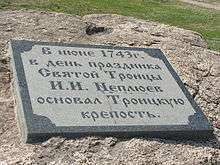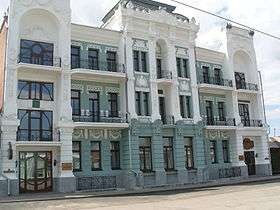Troitsk, Chelyabinsk Oblast
| Troitsk (English) Троицк (Russian) | |
|---|---|
| - Town - | |
 View of Troitsk | |
 Troitsk | |
|
| |
.png) |
|
|
| |
| Administrative status (as of September 2011) | |
| Country | Russia |
| Federal subject | Chelyabinsk Oblast |
| Administratively subordinated to | Town of Troitsk[1] |
| Administrative center of | Troitsky District,[1] Town of Troitsk[1] |
| Municipal status (as of September 2011) | |
| Urban okrug | Troitsky Urban Okrug[1] |
| Administrative center of | Troitsky Urban Okrug,[1] Troitsky Municipal District[1] |
| Mayor | Aleksandr Vinogradov |
| Statistics | |
| Population (2010 Census) | 78,372 inhabitants[2] |
| - Rank in 2010 | 209th |
| Time zone | YEKT (UTC+05:00)[3] |
| Founded | 1743 |
| Postal code(s)[4] | 457100 |
| Dialing code(s) | +7 35163 |
|
| |
| Troitsk on Wikimedia Commons | |
Troitsk (Russian: Тро́ицк) is a town in Chelyabinsk Oblast, Russia, located 175 kilometers (109 mi) east of the southern Ural Mountains and approximately 110 kilometers (68 mi) south of Chelyabinsk on the border with Kazakhstan. It stands on the east-flowing Uy River, a branch of the Tobol River. Population: 78,372 (2010 Census);[2] 83,862 (2002 Census);[5] 90,077 (1989 Census).[6]
Geography and climate
The Uy and Uvelka Rivers merge within the town boundaries and form a water body which serves as a reservoir for the nearby power station.
The landscape around the town is flat, although river valleys are hilly. The town is situated on the border of a forest-steppe zone. The climate is continental. The average temperature in January is −14 °C (7 °F), and +20 °C (68 °F) in July.
History

Troitsk was founded in 1743 by Ivan Neplyuyev as a head fortress of the Orenburg Line of forts during the Bashkir War of 1735-1740 and to protect the southern borders of Russia. It played a major role in the rebellion of Pugachev, who besieged and captured the town in 1774.

Gradually from a military settlement Troitsk has grown into a trading town with well-developed industry and nascent tourism.
Administrative and municipal status
Within the framework of administrative divisions, Troitsk serves as the administrative center of Troitsky District, even though it is not a part of it.[1] As an administrative division, it is incorporated separately as the Town of Troitsk—an administrative unit with the status equal to that of the districts.[1] As a municipal division, the Town of Troitsk is incorporated as Troitsky Urban Okrug.[1]
Economy
Troitsk serves as a railway junction and a supply and trading center for the southern Ural Mountains mining district. Through Troitsk trains pass to the Republic of Kazakhstan and further to the states of Central Asia. Other lines connect the Ural Mountains with the southern regions of Russia.
Near Troitsk are deposits of clay, sand, quartzite, granite, and rubble, used by the town's construction industry. The Russia-Kazakhstan border is immediately south of Troitsk (see photograph). Several large, cultivated field patterns (elongated, rectangular shapes) are visible through the snow-covered landscape, probably planted with spring wheat. Numerous circular, frozen lakes are scattered throughout the countryside around Troitsk.
The area in the Southern Urals Troitskaya GRES has significant industrial potential. Capacity of the Troitsaya GRES coal-fired power station is around 2000 Megawatts. Additional units with capacity of 660 Megawatt are being built. There is an electromechanical plant which makes heat transfer devices for powerful electric machines, a manufacturer of rockwool plates for Danish firm "Rockwool", a meat-packing plant, ferro-concrete products and parquet, a garment factory, and the railway and motor transportation enterprises. Small-scale businesses employ more than 6000 people.[7] .
Facilities
There are four higher educational institutions in Troitsk. Most significant of them is the Ural state academy of veterinary medicine. About 5,000 students are trained there.
Other higher educational institutions are branches.
Population
| Year | Inhabitants |
|---|---|
| 1897 | 23.299 |
| 1939 | 46.693 |
| 1959 | 76.325 |
| 1970 | 85.469 |
| 1979 | 87.500 |
| 1989 | 90.077 |
| 2002 | 83.862 |
| 2010 | 78.372 |
| 2012 | 78.089 |
| 2014 | 77.176 |
| 2015 | 76.453 |
Culture
Various festivals, competitions, and concerts take place during the year.
Tourism
Troitsk is one of the few places in the Ural region where the historical environment is well preserved. There are 948 cultural and historical monuments. The city of Troitsk has 4 architectural sites of federal importance: Cathedral of the Holy Trinity (1754), passage Yausheva brothers Bashkirov hotel and shopping arcades.[8]
References
Notes
- 1 2 3 4 5 6 7 8 9 Resolution #161
- 1 2 Russian Federal State Statistics Service (2011). "Всероссийская перепись населения 2010 года. Том 1" [2010 All-Russian Population Census, vol. 1]. Всероссийская перепись населения 2010 года (2010 All-Russia Population Census) (in Russian). Federal State Statistics Service. Retrieved June 29, 2012.
- ↑ Правительство Российской Федерации. Федеральный закон №107-ФЗ от 3 июня 2011 г. «Об исчислении времени», в ред. Федерального закона №271-ФЗ от 03 июля 2016 г. «О внесении изменений в Федеральный закон "Об исчислении времени"». Вступил в силу по истечении шестидесяти дней после дня официального опубликования (6 августа 2011 г.). Опубликован: "Российская газета", №120, 6 июня 2011 г. (Government of the Russian Federation. Federal Law #107-FZ of June 31, 2011 On Calculating Time, as amended by the Federal Law #271-FZ of July 03, 2016 On Amending Federal Law "On Calculating Time". Effective as of after sixty days following the day of the official publication.).
- ↑ Почта России. Информационно-вычислительный центр ОАСУ РПО. (Russian Post). Поиск объектов почтовой связи (Postal Objects Search) (Russian)
- ↑ Russian Federal State Statistics Service (May 21, 2004). "Численность населения России, субъектов Российской Федерации в составе федеральных округов, районов, городских поселений, сельских населённых пунктов – районных центров и сельских населённых пунктов с населением 3 тысячи и более человек" [Population of Russia, Its Federal Districts, Federal Subjects, Districts, Urban Localities, Rural Localities—Administrative Centers, and Rural Localities with Population of Over 3,000] (XLS). Всероссийская перепись населения 2002 года [All-Russia Population Census of 2002] (in Russian). Retrieved August 9, 2014.
- ↑ Demoscope Weekly (1989). "Всесоюзная перепись населения 1989 г. Численность наличного населения союзных и автономных республик, автономных областей и округов, краёв, областей, районов, городских поселений и сёл-райцентров" [All Union Population Census of 1989: Present Population of Union and Autonomous Republics, Autonomous Oblasts and Okrugs, Krais, Oblasts, Districts, Urban Settlements, and Villages Serving as District Administrative Centers]. Всесоюзная перепись населения 1989 года [All-Union Population Census of 1989] (in Russian). Институт демографии Национального исследовательского университета: Высшая школа экономики [Institute of Demography at the National Research University: Higher School of Economics]. Retrieved August 9, 2014.
- ↑ http://troick.su/htmlpages/Show/overview/Ogorode. Retrieved 2 December 2016. Missing or empty
|title=(help) - ↑ "Overview. This town". Retrieved 3 December 2016.
Sources
- Законодательное Собрание Челябинской области. Постановление №161 от 25 мая 2006 г. «Об утверждении перечня муниципальных образований (административно-территориальных единиц) Челябинской области и населённых пунктов, входящих в их состав», в ред. Постановления №2255 от 23 октября 2014 г. «О внесении изменений в перечень муниципальных образований (административно-территориальных единиц) Челябинской области и населённых пунктов, входящих в их состав». Вступил в силу со дня официального опубликования. Опубликован: "Южноуральская панорама", №111–112, 14 июня 2006 г. (Legislative Assembly of Chelyabinsk Oblast. Resolution #161 of November 25, 2006 On Adoption of the Registry of the Municipal Formations (Administrative-Territorial Units) of Chelyabinsk Oblast and of the Inhabited Localities They Comprise, as amended by the Resolution #2255 of October 23, 2014 On Amending the Registry of the Municipal Formations (Administrative-Territorial Units) of Chelyabinsk Oblast and of the Inhabited Localities They Comprise. Effective as of the official publication date.).
External links
 Chisholm, Hugh, ed. (1911). "Troitsk". Encyclopædia Britannica. 27 (11th ed.). Cambridge University Press. p. 300.
Chisholm, Hugh, ed. (1911). "Troitsk". Encyclopædia Britannica. 27 (11th ed.). Cambridge University Press. p. 300.- The official website of the town administration (Russian)
- The Information site about a city, All city history, the directory (Russian)